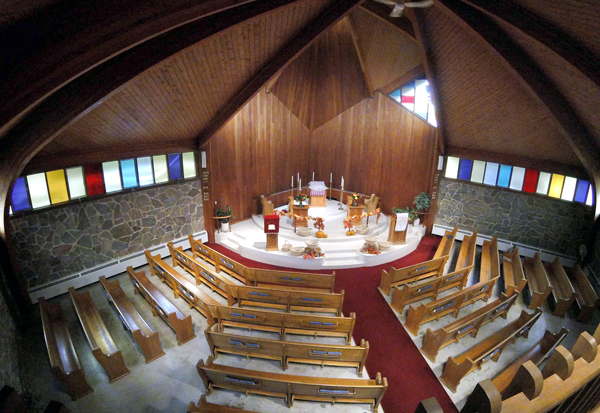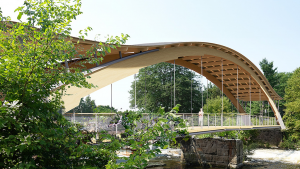John Lingwood, one of the most influential mid-century architects in Ontario’s Waterloo Region, is the subject of a documentary that premiered earlier this month.
Dwight Storring, the Kitchener, Ont.-based filmmaker who produced, directed and edited the 60-minute documentary film called Finding John Lingwood, said it is not just a story about the modernist architect who helped create the bricks and mortar look of the region, it’s about his life and contributions to the community.

“The film is really a story about John Lingwood’s life as a man as opposed to a chronology of his life or a survey of his work,” said Storring. “This was more of a quest. What I wanted to get at was what was John Lingwood like? What motivated him? What inspired him, and how that played out in his life and work.”
Storring had three motivations for wanting to do the film. The first one was personal. Storring began his career as a photo journalist for the Kitchener-Waterloo Record in 1980 and worked there for 25 years.
“I came of age professionally in one of John’s buildings, the Kitchener-Waterloo Record building on Fairway Road. It’s prominently featured in the film,” explained Storring. “The thing that came out of that was the depth of the experience I had in that building and how the building connected to the community and created community partly by virtue of the fact that it was a newspaper but also because of the activities of the people that were in the building.”
His second goal was to look at how brick and mortar buildings, and Lingwood’s buildings in particular, add to the larger community narrative.
“When you talk about the larger community narrative, if you think of Waterloo Region, it tends to be a place where entrepreneurship is welcome,” said Storring.
His third goal was to highlight Carmel New Church, one of the buildings Lingwood designed in Kitchener.
Rick Haldenby, the former head of the University of Waterloo School of Architecture, said the church is “one of the most extraordinary pieces of modern architecture in the country.”
In addition to the Record and Carmel New Church, the film also examines the 20 homes Lingwood designed on Manchester Road in Kitchener, one of them was the Lingwood family home. The film premiered Jan. 17 in Waterloo.
After attending the University of Manitoba and spending a few years in Detroit as a draftsman, Lingwood moved to Kitchener in 1955 at the age of 32 with his wife and three children to start his business.
“By the end of the decade he is one of the leading architects in the community,” Storring noted.
“He goes on to complete close to 700 projects during the time he was in practice from 1955 to 1992.”
Although Lingwood was a prominent architect, he was also an “ordinary guy,” Storring pointed out.
“He is much like the rest of us that get rooted in a place. He raised a family, he had many lifelong friends, he spent time at his cottage. That’s at the heart of the work that I’ve been doing since I started doing documentary work in 2010, is looking at how ordinary people have an impact on the larger community,” said Storring.
“I wanted to approach this from a personal point of view, not just my personal point of view but from the personal point of view of the subjects that I was interviewing. I approached family, clients, colleagues and those who have occupied his buildings.”

Storring describes Lingwood as a maverick.
“His early work from ‘55 to the late ‘60s was very much in the modernist style; a lot of low slung buildings, plenty of windows, fieldstone, wood. I believe that was the style he was most at home with and the one that really came from his heart,” Storring noted.
Over time, his style changed.
“John was a pretty good business man and realized that as time went on he needed to investigate other styles in architecture because the environment at that point in Waterloo Region was pretty competitive. There were probably seven major firms who were really getting most of the work and influencing what the area looked like,” said Storring.
“He moved into what I call his transitional period where he was combining some of the ideas from the first period with some more modern ideas such as precast concrete walls and decorative things.
“A little later, he moved into the brutalist style, a lot of concrete cubes stacked in various ways.”
Lingwood loved spending time at the family cottage on Burnt Island in Georgian Bay, which was sold after his death in 1996.
As part of research for the film, Storring took Lingwood’s daughter Lisa, who was instrumental in providing insight into Lingwood’s family life, back to the cottage her father designed and built.
“That trip forms the emotional heart of the film,” Storring said. “I think the cottage really formed a deep part of him and, in my personal quest to find John Lingwood, as I called the film, I think I found him there at the cottage site because it’s a natural implementation of his love of stone and wood and nature.”
The film was produced with a grant from the Region of Waterloo Arts Fund, financial support from WalterFedy and the Grand Valley Society of Architects, which also provided personal support from its members, Storring said.









Recent Comments
comments for this post are closed